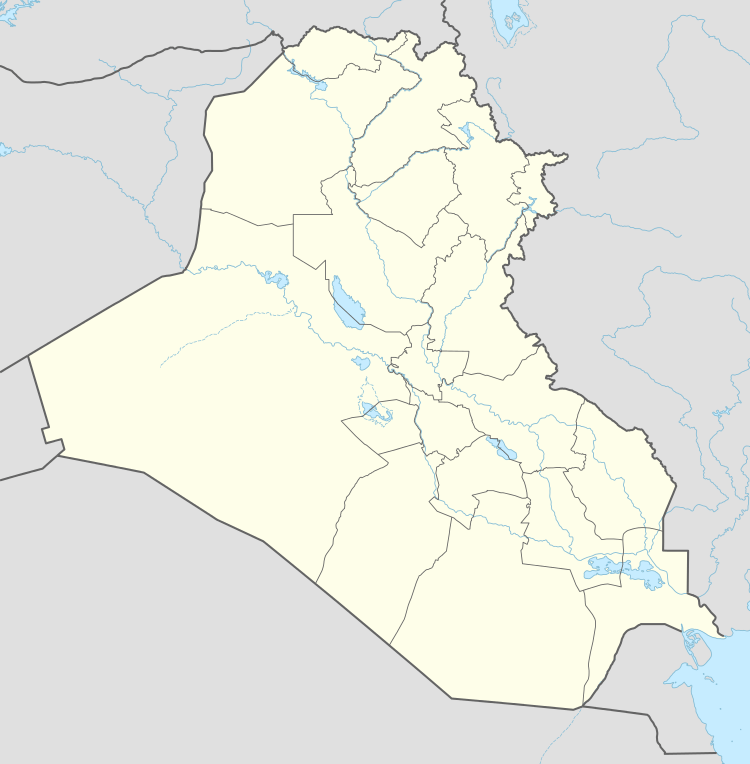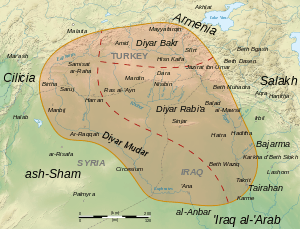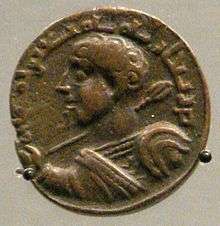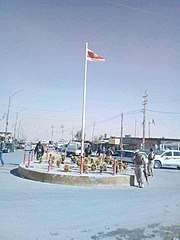Sinjar
Sinjar (Arabic: سنجار, romanized: Sinjār;[2] Kurdish: شنگال, romanized: Şingal[3][4], Syriac: ܫܝܓܪ, romanized: Shingar[5]) is a town in the Sinjar District of the Nineveh Governorate in northern Iraq. It is located about five kilometers south of the Sinjar Mountains. Its population in 2013 was estimated at 88,023.[6] The town is one of the main settlement areas of the Yazidis and is also home to Sunni Muslim Arabs and Turkmens and Christians.
Sinjar سنجار (Arabic); Şingal (شنگال Kurdish) | |
|---|---|
 Sinjar Location within Iraq | |
| Coordinates: 36°19′21″N 41°51′51″E | |
| Country | |
| Governorate | Nineveh |
| District | Sinjar District |
| Government | |
| • Mayor | Fahad Hamid Omar[1] |
| Elevation | 522 m (1,713 ft) |
| Population (2013) | |
| • Total | 88,023 |
| Time zone | UTC+3 (GMT) |
History
Antiquity

In the 2nd century AD, Sinjar became a military base called Singara and part of the Roman limes.[7] It remained part of the Roman Empire until it was sacked by the Sasanians in 360.[7] Starting in the late 5th century, the mountains around Sinjar became an abode of the Banu Taghlib, an Arab tribe.[8] At the beginning of 6th century, a tribe called Qadišaiē (Kαδίσηυοι) dwelt there.[7] According to the early Islamic literary sources, Singara had long been a bone of contention between the Sasanian and Byzantine empires and several times switched hands between the two empires.[8] A 6th-century sources describes the population of Singara being composed of Zoroastrians, Christians and Jews.[8] There are few visible traces of the ancient town of Singara.[8]
Islamic era

Sinjar was conquered in the 630s–640s by the Arab Muslims led by the commander Iyad ibn Ghanm and thereafter incorporated into the Diyar Rabi'a district of the Jazira province.[8] In 970, the city was conquered by the Hamdanid dynasty, a branch of the Banu Taghlib tribe.[8] Toward the end of the century, another Arab dynasty, the Uqaylids captured the city and erected a citadel there.[8] Beginning with the rule of the Turkmen atabeg Jikirmish in 1106/07, Sinjar entered its most prosperous historical period lasting through the mid-13th century. The Zengid ruler Nur ad-Din conquered the area in 1169 and 1171; in the latter year, a cadet branch of the Zengids was established in Sinjar under Zengi II (r. 1171–1197), whose court was noted for its high culture.[8] The scholar Ibn Shaddad (d. 1186) noted that Sinjar was protected by a double wall, the first being the original wall built by the Uqaylids and the newer wall built by the local Zengid ruler Qutb ad-Din Muhammad (r. 1197–1219).[8] Also noted by Ibn Shaddad were two mosques, six madrasas (schools of Islamic law) for the Hanafi and Shafi'i schools of jurisprudence, a mashhad (shrine) dedicated to Ali ibn Abi Talib and three khanqas (buildings for Sufi gatherings) and Ibn al-Adim (d. 1262) further notes a zawiya (Sufi lodge).[8] A surviving mosque minaret from this era, remarked on by the 19th-century epigraphist Max van Berchem, contains an inscription crediting Qutb ad-Din as the minaret's builder in 1201.[8]
The city came under Ayyubid rule during the reign of Saladin and was controlled by the Ayyubid ruler of the Diyar Bakr district of the Jazira, al-Ashraf Muzaffar al-Din (r. 1210–1220). It later was controlled by the ruler of Mosul, Badr al-Din Lu'lu'.[8] The Ilkhanid Mongols destroyed the double wall of Sinjar and the mashhad of Ali in 1262; the mashhad was rebuilt afterward by the Ilkhanid's Persian governor of the area Muhammad al-Yazdi.[8] Ibn al-Adim and al-Dhahabi (d. 1348) list several Islamic scholars who hailed from Sinjar, including the polymath Ibn al-Akfani (d. 1348). The geographer Zakariya al-Qazwini (d. 1283) referred to Sinjar as "little Damascus", noting in particular the similarities of Sinjar's ornate bathhouses with their mosaic-laced floors and walls and octagonal stone pools.[8] During his visit of the city, Ibn Batuta (d. 1369) remarked that Sinjar's congregational mosque was encircled by a perennial stream.[8]
The Timurid successors of the Ilkhanids captured Sinjar after a seven-month siege according to oral traditions cited by Evliya Celebi (d. 1682).[8] The city was later conquered successively by the Turkmen tribes of Ak Koyunlu and Kara Koyunlu before being taken by the Safavid dynasty of Iran in 1507/08.[8] During the Ottoman–Safavid War (1532–1555), Sinjar was captured by the Constantinople (Istanbul)-based Ottoman Empire in 1534.[8] The city became the center of its own sanjak (district) within Diyarbekir Eyalet (province of Diyarbakir).[8] It was later reduced to being the administrative center of its own nahiya (subdistrict) of the Mardin Sanjak.[8] Writing in the 17th century, Evliya Celebi noted that the population of the city of Sinjar was composed of Kurds and Arabs from the Banu Tayy tribe, while the Sinjar Mountains were inhabited by 45,000 Yazidis and Kurds.[8]
After 1830, the nahiya of Sinjar became part of the Mosul Sanjak.[8] During the 19th century, the Yazidis of the Sinjar Mountains often posed a threat to travelers in the region. The governor Dawud Pasha of Baghdad (in office in 1816–1831) was unable to suppress the Yazidis and the Yazidi revolts of 1850–1864 were ended after the diplomatic efforts of the Ottoman statesman Midhat Pasha enabled the authorities to tax and impose customs in the area.[8]
Modern era
In 1974–1975, five neighborhoods in the city of Sinjar were Arabized during a campaign by the Iraqi government of President Saddam Hussein dubbed as a "modernization drive"; the neighborhoods were Bar Barozh, Saraeye, Kalhey, Burj and Barshey, whose inhabitants were relocated to the new towns or elsewhere in Iraq and replaced by Arabs.[9] The majority of the Arabs resettled in the Sinjar Mountains have remained in the region as of 2010.[10]
On 13 August 2009, a suicide bombing killed 21 people and wounded 32 in a cafe in the Kalaa neighborhood of Sinjar.[11] On 14 August 2010, a series of truck bombings by al-Qaeda in Iraq in the towns of Qahtaniya and al-Jazira, both in the Sinjar District, killed 326 Yazidis and injured 530 more.[12]
According to statistical survey of the Sinjar District in 2013, the city of Sinjar had a population of 77,926. The ethnic composition of the city consisted of Kurds, Arabs, Turkmens, and Assyrians and the religious composition consisted of Yazidis, Sunni Muslims, and Christians. There were 23 primary schools, three intermediate schools and seven secondary schools, a hospital, two other health care facilities, three public parks and two sports fields.[13] The town had three churches, a Syriac Orthodox Church, Syriac Catholic Church, and Armenian Apostolic Church, all of which were destroyed by the Islamic State of Iraq and the Levant.[14][15]
Northern Iraq Offensive (2014)
In the course of their second Northern Iraq offensive in August 2014, the Islamic State of Iraq and the Levant (ISIL) took over large areas of Nineveh province. Following the withdrawal of the Kurdish Peshmerga they captured the city of Sinjar on 3 August. During the following days, IS militants perpetrated the Sinjar massacre, killing 2,000 Yazidi men and taking Yazidi women into slavery, leading to a mass exodus of Yazidi residents. According to a United Nations report, 5,000 Yazidi civilians were killed during ISIL's August offensive. It is also known as the genocide of Yazidis by ISIL. The genocide was enabled partly as a result of the Peshmerga flight from the ISIL offensive, which left the Yazidis defenseless.[16][17][18]
On the night of 20 December 2014, in the course of a first offensive to retake Sinjar from ISIL militants, Kurdish forces pushed into the city.[19] However, the Kurdish advance into Sinjar was stalled, as they faced stiff resistance from ISIL militants inside the southern half of the city.[20]
On 13 November 2015, a day after launching a major second offensive, Kurdish forces and Yazidi militias backed by US airstrikes, entered the city and fully regained its control from ISIL.[21] Following the recapture, in the nearby hamlet of Solagh, east of Sinjar city, Kurdish forces found a mass grave with the remains of at least 78 Yazidi women from Kocho village believed to be executed by ISIL militants.[22][23] Following the recapture of Sinjar, Yazidi groups engaged in revenge looting and burnings targeting Sunni Muslims, as well as reprisal killings.[24][25]
Declaration of autonomy

In August 2017, the Yazidis of Sinjar declared their government autonomous at a press conference.[26] Peshmerga forces withdrew from Sinjar on October 17, 2017, allowing the Iraqi Army and the Popular Mobilisation Units (PMU) to enter the town. The control of the town was handed over to the PMU-backed Yazidi group called "Lalesh Brigades" after Peshmerga's withdrawal.[27][28][29][30]
In June 2020, the United States Commission on International Religious Freedom accused Turkey that during the Operations Claw-Eagle and Claw-Tiger, Turkey threatened Yazidis families who attempted to return to their homes in the town. Turkey rejected the claims.[31]
Notable people
- Ahmad Sanjar, Sultan of the Seljuk Empire
See also
- Disputed territories of Northern Iraq
- Yazidi genocide
- Military intervention against ISIL
- American-led intervention in Iraq (2014–present)
References
- http://www.basnews.com/index.php/en/news/kurdistan/283611
- "SINCAR IN THE LAST PERIOD OF OTTOMANS (SOCIAL AND ECONOMICAL SITUATION)".
- Rêsan Ḧesen (2011). Şingal: wek qutabxana sitrana filklorî ya Kurdî (in Kurdish).
- "Şingal ... شنگال". sverigesradio.se (in Kurdish). Sveriges Radio. Retrieved 9 December 2019.
- Thomas A. Carlson et al., “Sinjar — ܫܝܓܪ ” in The Syriac Gazetteer last modified June 30, 2014, http://syriaca.org/place/184.
- "Iraq: largest cities and towns and statistics of their population". World Gazetteer.
- Alexander 1985, p. 27.
- Haase 1997, p. 643.
- Savelzberg, Hajo & Dulz 2010, pp. 103–104.
- Savelzberg, Hajo & Dulz 2010, p. 111.
- "On Vulnerable Ground: Violence against Minority Communities in Nineveh Province's Disputed Territories" (PDF). Human Rights Watch. 2009. pp. 30, 43. Retrieved 19 December 2019.
- Savelzberg, Hajo & Dulz 2010, pp. 107–108.
- "Emerging Land Tenure Issues among Displaced Yazidis from Sinjar, Iraq: How Chances of Return may be Further Undermined by a Discrimination Policy Dating Back 40 Years" (PDF). United Nations Human Settlements Programme in Iraq. November 2015. p. 34. Retrieved 19 December 2019.
- "Giving Thanks in Front of a Broken Altar in Iraq". Preemptive Love. 23 November 2016. Retrieved 9 June 2020.
- Mogelson, Luke. "The Fight for Mosul". The New Yorker. Retrieved 9 June 2020.
- Phillips, David L. (29 November 2018). The Great Betrayal: How America Abandoned the Kurds and Lost the Middle East. Bloomsbury Publishing. ISBN 9781786735768.
- Murad, Nadia (7 November 2017). The Last Girl: My Story of Captivity, and My Fight Against the Islamic State. Crown/Archetype. ISBN 9781524760458.
- "Isil carried out massacres and mass sexual enslavement of Yazidis, UN confirms". Daily Telegraph. 14 October 2014. Retrieved 27 October 2015.
- "Iraq's Kurds press offensive against Islamic State in Sinjar". DPA International. Archived from the original on 4 January 2015. Retrieved 21 December 2014.
- "Iraqi Kurds Advance Against Islamic State in Sinjar". Wall Street Journal. Retrieved 21 December 2014.
- "Battle for Sinjar: IS-held town in Iraq 'liberated'". BBC News. 13 November 2015.
- Isabel Coles (14 November 2015). "Mass Yazidi grave discovered after Iraq's Sinjar taken from Islamic State". Reuters. Retrieved 14 November 2015.
- "Mass grave of 'Yazidi women executed by ISIS' found in Iraq". AFP. 14 November 2015. Retrieved 14 November 2015.
- "Yazidis burn Muslim homes in Iraq's Sinjar: witnesses". Yahoo News. 15 November 2015.
- "Yazidis Get Revenge On ISIS In Sinjar". The Daily Beast. 3 December 2015.
- Emo, Salim; Seyid, Mehabad (August 22, 2017). "Êzidî women: Autonomy will bring freedom". ANF News. Retrieved August 22, 2017.
- Szlanko, Balint (17 October 2017). "Iraq: After losing Kirkuk, Kurdish forces pull out of Sinjar". CTVNews.
- Martin Chulov. "Iraqi forces drive Kurdish fighters out of town of Sinjar". Retrieved 18 November 2017.
- Iraqi-backed Yazidi group takes over Sinjar after Kurdish pullout Middle East Eye
- Yazidis caught in 'political football' between Baghdad, Iraqi Kurds Reuters
- Turkey rejects US body's accusations on anti-terror ops
Bibliography
- Alexander, Paul J. (1985). The Byzantine Apocalyptic Tradition. University of California Press. pp. 27. ISBN 0520049985.CS1 maint: ref=harv (link)
- Haase, C. P. (1997). "Sindjar". In Bosworth, C. E.; van Donzel, E.; Heinrichs, W. P. & Lecomte, G. (eds.). The Encyclopaedia of Islam, New Edition, Volume IX: San–Sze. Leiden: E. J. Brill. pp. 643–644. ISBN 90-04-10422-4.
- Savelzberg, Eva; Hajo, Siamend; Dulz, Irene (July–December 2010). "Effectively Urbanized: Yezidis in the Collective Towns of Sheikhan and Sinjar". Études rurales (186): 101–116. JSTOR 41403604.CS1 maint: ref=harv (link)
Further reading
- Mironova, Vera; Hussein, Mohammed (June 5, 2017). "The Struggle Over Sinjar". Foreign Affairs. ISSN 0015-7120.